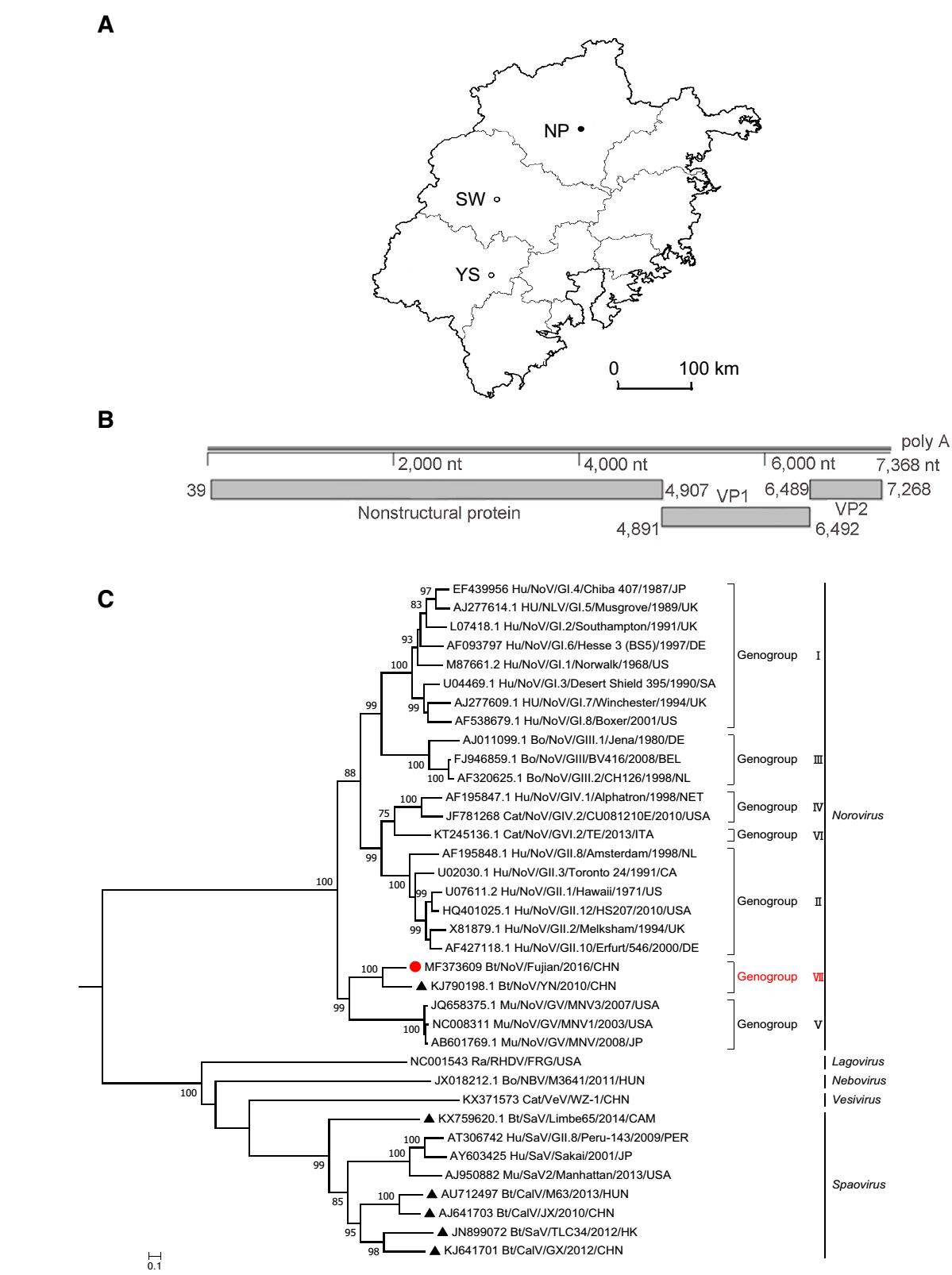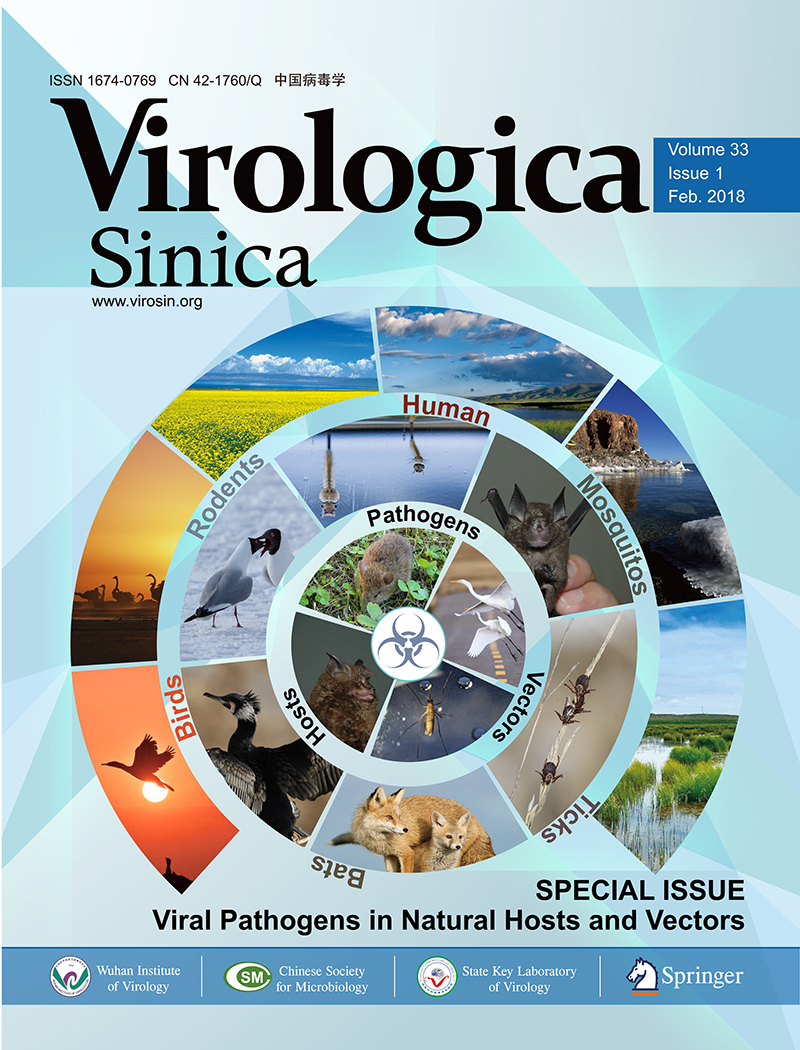HTML
-
Noroviruses (NoVs) are second only to the rotaviruses as etiologic agents of acute fulminant gastroenteritis in infants and young children worldwide, with an estimated 200, 000 deaths per year in children younger than 5 years of age in developing countries (Patel et al. 2008). NoVs are classified within the genus Norovirus of the family Caliciviridae with Norwalk virus as its prototype member (ICTV 2017). The virions are small (38-40 nm in diameter) nonenveloped, with an icosahedral capsidanda linear, positive-sense, single-stranded, 7.7 kb RNA genome that is organized into 3 open-reading frames (ORF) (Green 2013). While only one species is currently recognized within the genus, molecular epidemiological studies have demonstrated a marked genetic diversity among circulating NoVs, and genotyping has been proposed based on relatedness within the complete VP1 capsid protein (Green 2013). Such a system has divided members into 6 major phylogenetic clades or genogroups, designated GI through GVI and sharing 46.1%-58.8% nucleotide (nt) identities in their VP1 gene. Clades GI, Ⅱ, and Ⅲ are further subdivided into 9, 21, and 3 genotypes, respectively, indicating the need for further characterization of species criteria (Green 2013).
NoVs have been detected in a number of mammalian species (De Graaf et al. 2017). Strains infecting humans are found in GI, GII and GIV, while porcine NoVs group in distinct genotypes within GII, bovine and ovine viruses belong exclusively to GIII, murine NoVs are grouped in GV, canine NoVs are in GIV and GVI, and lion viruses have been found only in GIV (Green 2013).
As one of the most widely distributed mammals, bats are important natural reservoirs of viruses, of which more than 137 have been discovered (Luis et al. 2013), including many highly pathogenic agents such as Hendra and Nipah viruses (Yob et al. 2001), SARS-related coronaviruses (Ge et al. 2013), and Marburg virus (Amman et al. 2012; Towner et al. 2009). Bats have also been found to harbor diverse caliciviruses, in countries including China, Hungary, and Cameroon, all showing close relationship with members of the genus Sapovirus (Kemenesi et al. 2016; Tse et al. 2012), Nevertheless, only one sequence (accession number: KJ790198) and several 660 nucleotides (nt) amplicons of bat-borne NoVs, from China, has been reported (Hu et al. 2017).
In 2016, 178 adult bats were collected from Yanshi, Shawu and Nanping in Fujian province, southeast China. The collection comprised 4 species: Rhinolophus sinicus (Yanshi, n = 48; Nanping, n = 1), Hipposideros armiger (Nanping, n = 10), Rhinolophus affinis (Nanping, n = 62; Shawu, n = 21), and Myotis horsfieldii (Shawu, n = 36) (Fig. 1A). All bats were live-captured with nets near or within human inhabited communities, and were apparently healthy at capture. Anal specimens were collected using sterile swabs, immediately transferred to viral transport medium, and stored in liquid nitrogen after sample collection, as described previously (He et al. 2017). As part of another investigation, all were tested for group A rotaviral RNA and found negative. Samples from each location were pooled and subjected to viral metagenomic analysis as per our published method (He et al. 2013).Ten contigs were annotated to NoVs, with an average length of 189 nt and showing 68%-79% nt sequence identity with other known NoVs, these were used to design PCR primers, targeting 239 nt of the polyprotein gene (forward primer sequence: 5′-CAACTGTGACCGCATAGAG-3′; reverse primer sequence: 5′-TGAGGACGAGGTGGGAATG-3′). RNA of the samples was extracted using QIAamp RNA Mini Kit (Qiagen, Hilden, Germany), and subjected to RT-PCR screening, with 35 circles of 94 ℃ for 30 s, 58 ℃ for 30 s and 72 ℃ for 30 s. RT-PCR with double-distilled water replacing the RNA was included as a negative control. Results showed that 2 of 62 (3.2%) R. affinis collected from Nanping were positive. Preliminary phylogenetic inspection of the amplicons showed that they shared 99.8% nt identity, and the viruses from which they originated were named NPIH26 and NPIH29. The genomic sequence of NPIH26 was then determined using a long-range PCR system (TaKaRa, Dalian, China) and Rapid Amplification of cDNA Ends (RACE, TaKaRa). Results showed that the complete genome (GenBank accession number: MF373609) was 7368 nt in length with 58.05% CG content and possessed genomic organization typical of noroviruses, containing three ORFs encoding the multifunctional nonstructural protein, VP1 and VP2, as well as 5′ leader and 3′ trailer sequences (38 and 33 nt respectively) (Fig. 1B). The conserved motifs DYXX(TR)WDST, GLPSG and YGDD were observed and the genome contained the same structures in the RNA-dependent RNA polymerase region as other NoVs (Kemenesi et al. 2016; Smiley et al. 2002; Wolf et al. 2011).

Figure 1. A Sampling location of this study, filled circles: bats positive for norovirus; open circles: negative. B Genomic structural schematic representation of NPIH26. Boxes represent the open reading frames encoding main proteins, nonstructural protein (39-4907 nt), VP1 (4891-6492 nt) and VP2 (6489-7268 nt). C Phylogenetic analysis of NPIH26 (filled red circle) and representatives of other caliciviruses based on their complete VP1 amino acid sequences. Other bat-borne caliciviruses are indicated by filled black triangles. Genogroups within the genus Norovirus are shown next to brackets, with the new genotype proposed in this study in red.
Genomic comparison with representatives of the six NoV genogroups and other caliciviruses showed that NPIH26 shared the highest nt identity (73%) with the bat NoV BtRs-CalV/YN2010 identified in R. sinicus from Yunnan, China (Genbank accession number: KJ790198), although lacking ~ 1000 nt at the 5′ end. Shared identities with other NoVs, were ≤ 59.6% and ≤ 46.7% with other caliciviruses including bat caliciviruses (Table 1). To determine the phylogenetic relationship, the VP1 genes of these viruses were aligned using ClustalW, available in MEGA6, and a phylogenetic tree was constructed by the maximum likelihood and general time reversible models under evaluation of 1000 bootstraps. The viruses clustered within five groups corresponding to their genera within the family Caliciviridae, with NPIH26 placed with other NoVs but forming a phylogenetic group with BtRs-CalV/YN2010 separate from the six currently known genogroups. Accordingly, these bat-borne NoVs can be considered as comprising a new genogroup, GVII (Fig. 1C). ORF1 and VP2 were also used for phylogenetic analyses and showed similar topology with that of VP1 (data not shown).

Table 1. Amino acid and nucleotide sequence identity comparison between NPIH26 and other representatives
Kunming mice (3 day-old) were inoculated intraorally with positive sample NPIH26 for virus isolation with daily inspection for any visible pathology. At 7 days, without showing any signs of morbidity or weight loss, all mice were euthanized and their organs (intestines with contents, lungs, livers, kidneys and spleens) were removed and subjected to specific RT-PCR detection. All organs tested negative for this virus.
Of all the noroviruses, only murine strains have been propagated in cell culture. Consequently, the inability to cultivate human NoVs in vitro has been a major obstacle to the development of antivirals and vaccines to cure or prevent human noroviral diseases (Green 2013). A recent breakthrough study, however, has shown that human NoVs can replicate efficiently in stem cell-derived multicellular human intestinal epithelial cultures called enteroids, which may overcome this obstacle (Ettayebi et al. 2016).
Noroviral infections of children in China and the rest of the world pose a huge health and financial burden on their families and the communities (Ahmed et al. 2014). No case of human noroviral diarrhea has so far been found to have an animal origin, as viruses of different animal origin have evolved within distinct genogroups (Fig. 1C). However, phylogenetic analyses have shown that some human NoVs (e.g. Hu/NoV/GIV.1/Alphatron/1998/NET, Fig. 1C) share a close relationship with non-human viral members of the genus (e.g. Cat/NoV/GIV.2/CU081210E/2010/USA, Fig. 1C), which illustrates the complicated evolutionary history of NoVs of different host origins. Bats can spread many pathogens to humans, including those causing diarrhea; e.g. group A rotaviruses (He et al. 2017). So far only a few NoVs have been reported in bats, but there is a high likelihood that more strains are circulating in the bat populations. The divergent relationships of bat NoVs with other NoVs may help our understanding of evolutionary origins of this virus.
-
This work was supported by General Program of the National Natural Science Foundation of China (31572529), the National Key Basic Research and Development Program of China (2016YFC1200100), the Youth Innovation Fund of the Academy of Military Medical Science (2015CXJJ28).
-
The authors declare that they have no conflict of interest.
-
The sampling of bats was approved by the Administrative Committee on Animal Welfare of the Military Veterinary Institute, Academy of Military Medical Sciences, China (Laboratory Animal Care and Use Committee Authorization, Permit Number: JSY-DW-2015-01).
-
This article is distributed under the terms of the Creative Commons Attribution 4.0 International License (http://creativecommons.org/licenses/by/4.0/), which permits unrestricted use, distribution, and reproduction in any medium, provided you give appropriate credit to the original author(s) and the source, provide a link to the Creative Commons license, and indicate if changes were made.














 DownLoad:
DownLoad: